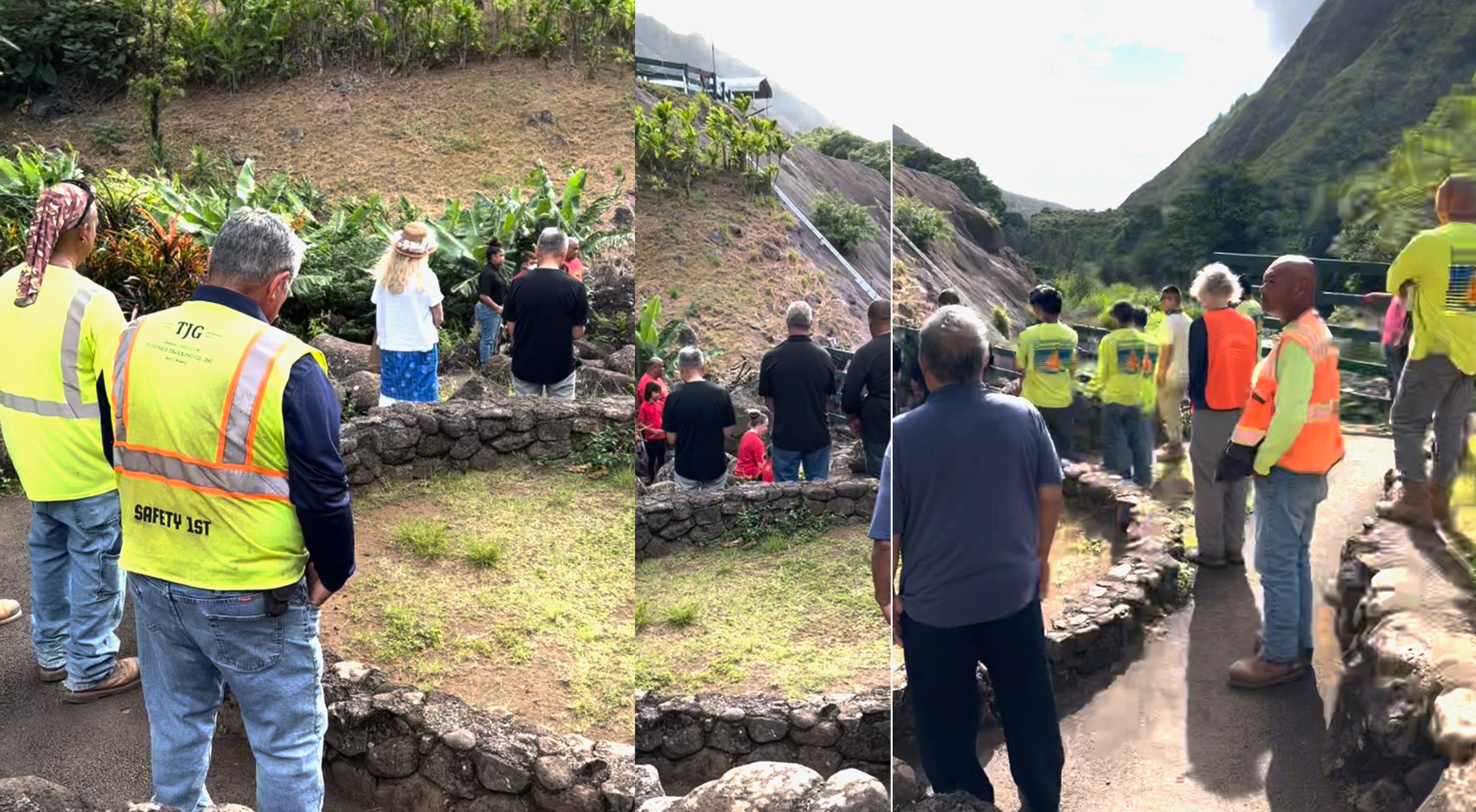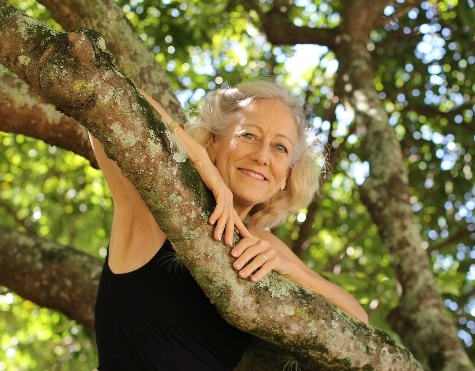
by Renée Tillotson
Inhale and listen. For someone who has trained herself as a “doer” her whole life, I don’t recall going into a situation with much receptivity. I often enter with a predetermined plan for what I am bringing to the table, for what I am sharing, for what I want to know.
“Let’s see what unfolds,” has not typically been my modus operandi in a new context. Perhaps I don’t need to start by asking people a lot of questions, expecting to be given answers. What if I were to enter with a little less self-assertion, a little more humility? How about starting with quiet listening, a gentle openness?
Before coming to Hawai’i, it would NEVER have occurred to me to ask permission to enter a place.
So for me, this difference of approach has instigated a huge cultural and life-style turn around. I’m just starting to realize how revolutionary this has been. This more humble approach affects everything, down to the way we touch other people, how we feel our way into conversations, how we test the waters, picking up signals as we go… rather than brashly charging in.
To a certain extent, I’m recognizing this tendency as a member of a domineering, accomplishment-oriented culture, educated to learn through probing inquiry. And I am also acknowledging this as a personal tendency that I’m wanting to learn my way out of.
Another big lesson in receptivity blessed me recently. And it resulted in a startling archeological discovery.
Our family’s company, Prometheus Construction, has been contracted to stabilize the side of a riverbed in ‘Iao Valley on Maui, a valley in which the highest of Maui’s nobility, ali’i, lived and were buried for hundreds of years. It’s a lush, stunningly beautiful river gorge beneath the ‘Iao Needle, a lofty stone spire hurtling upward into the sky.
Over the last 20 years in Hawai’i, Prometheus Construction has developed something of an island approach, not just crashing in with a “Here we are and this is what we are doing!” attitude.
Certainly, approaching this job required us to be receptive to long-held island sensitivities and perspectives. For those of you who may not be familiar with the ahupua’a of ancient Hawai’i, these wedge-shaped land divisions follow the natural watersheds of the islands. Within the ahupua’a, the traditional Hawaiian community lived and worked together from mauka to makai (from the mountain to the sea) farming land crops from the top, down to farming fish at the shore. The highest principle of sustainability for the ahupua’a was protecting their precious watershed.
The first contractor to work on the ‘Iao Valley job site where we are now contracted to work evidently came in and plunked their heavy equipment right into the middle of the ‘Iao Valley riverbed. Can you imagine how that would have grated on Hawaiian sensitivities? A big, noisy, greasy piece of machinery in a pristine waterway?
As the Construction Supervisor for Prometheus, our son Govi made thoughtful plans to perform our work as non-invasively as possible. He had our fabricator create an extra-long arm for our excavator, with a heavy concrete block on the back for counterbalance, so that we could keep our equipment on the top of the riverbank while drilling long “soil nails” into the side of the river bank to stabilize it.
For the morning of the blessing, Govi invited all the relevant public officials and inspectors, as well as the neighbors living immediately below ‘Iao Valley State Monument where we were working. Most importantly, he invited a local Hawaiian cultural practitioner, in fact, a kumu hula, to give the blessing ceremony: Kapono Kamaunu.
Cliff and I met Govi at the construction site in advance of our guests’ arrival. We had brought 3 maile lei, the traditional Hawaiian fragrant vine-like lei made for special occasions and sacred ceremonies. Govi had large ice chests of cool drinks and plenty of good “grinds” on hand, without which no island gathering is complete!
Kumu Kapono Kamaunu arrived with a small entourage, including Kahu Kekai Robinson with some of her students and teachers from the Hawaiian language and culture immersion school, Ke Kula ‘O Pi’ilani. As it turns out, she was the only one in attendance whose ancestors come from ‘Iao Valley – her participation graced our ceremony. Our kumu for the day thoughtfully surveyed the venue for the best location to hold the blessing, choosing a circular area adjacent to our job site. This was not to be a formulaic event. He would adapt it to the needs of the moment as he perceived them.
After sounding a conch shell in the four directions, our kumu asked Kahu Kekai to give an oli, a Hawaiian chant, asking permission to enter. Her sonorous voice echoed up the sides of the valley, reverberating through our skin, our bones. The kumu later commented on how the sun came out from behind the clouds just as her oli ended. Our request for permission to enter the site had been granted. Watching Kekai herself, Cliff noticed that after giving her powerful chant, Kekai slipped back into an attitude of humility. Perhaps humility is a requirement for receptivity. Being humble (ha’a) allows us to get out of our own way, doesn’t it?
As one of the teachers from Kahu Kekai’s school explained to me after the ceremony, listening for the voices of the ‘aina, the land, is something his people do continually. He was standing with one of his slippers off, so that he could better “hear” with his foot what the land had to say. He explained how they listen for signals all the time. A fierce, sudden wind springing up will cause him to pause what he’s doing, while a soft, gentle breeze (both of which are the subject of many Hawaiian songs, chants and hulas) will invite and encourage him to continue, to move forward.
Now for the ceremony itself, our kumu had a surprise for us, asking Kahu Kekai’s school children and their teachers to set up a pounding board for making traditional kapa (tapa cloth). The children and adults of the school then played a percussive piece, with one teacher and one student pounding the kapa board and the others rhythmically pounding special sticks together. The kumu now called upon all the ancestors and living beings of the valley to listen to the pounding sound of good work being done in the valley again.
Kumu Kapono later told me about his realization driving home from work the day before: the valley and all the beings in the valley needed to hear the sound of good work again. Even though our construction pounding was going to be much louder than the pounding of kapa cloth, the intent should be the same: to perform good work. To me this was an instance of receptivity on his part: wanting the job to go well, wanting to give an appropriate blessing ceremony to help that happen, and being open to inspiration in crafting his blessing. In this way he came upon this brilliant, unique approach.
The kumu now spoke to all of us gathered there, and in particular to all our co nstruction workers who were going to engage in this rigorous and potentially dangerous work. He talked about the historic, sacred, and energetically powerful location at which we were standing. He went on to explain the different Hawaiian energy centers (piko) in the human constitution, from the crown of the head to the feet. And he advised each person to take 5 minutes at the start of the workday and 5 minutes at the end to clear their minds and find the calm center within themselves. In so doing, they would protect themselves to safely move through their day.
nstruction workers who were going to engage in this rigorous and potentially dangerous work. He talked about the historic, sacred, and energetically powerful location at which we were standing. He went on to explain the different Hawaiian energy centers (piko) in the human constitution, from the crown of the head to the feet. And he advised each person to take 5 minutes at the start of the workday and 5 minutes at the end to clear their minds and find the calm center within themselves. In so doing, they would protect themselves to safely move through their day.
As the president of Prometheus Construction, I thanked the kumu for his blessing, assured him and all who were assembled that our family and company feel honored to work at this historic site, that our intention is to respect and preserve the valley, and that I trust our workers will take the time to follow his recommendation at the beginning and end of the day.
After asking Govi to fetch water from the river in a koa wood bowl, the kumu mixed salt from the sea with the fresh water, then used the protective leaf of a ti plant to sprinkle the surrounding area and all the participants with blessings, all while chanting in Hawaiian. Still wearing the maile lei we had given to him, he next asked Kahu Kekai and our son Govi to each take a lei and hang it symbolically over two distant fence posts, representing, it seemed, the two ends of our job site. At Cliff’s request, he allowed Govi to use the remaining ceremonial water to bless our equipment.
Meanwhile, Kahu Kekai was hanging her lei when the curious discovery was made. Here was Kahu Kekai, she and her family having lived in ‘Iao Valley for generations, and she bringing the school children there on a daily basis. And yet, as she humbly hung the maile lei over the fence post, her eyes connected with a sight she had never taken in before, something from the distant past.
To gain the kingdom of heaven is to hear what is not said, to see what cannot be seen, and to know the unknowable – that is Aloha.
-Queen Lili’uokalani
She had found an ancient Hawaiian kōnane game board carved into a stone “table” with a stone bench on either side of the “table.” Like chess, kōnane is a game of strategy. Looking at it, one can almost imagine two young ali’i, aspiring warriors battling their pieces of coral and lava rock across the board under the watchful eye of an elder warrior. Now, this game table with seats is an archeological rarity hardly ever found, even when someone is looking for them. And this one was nestling right next to a fence Kekai had stood at dozens or hundreds of times. In this sacred context, she seemed to have opened an exceptional receptivity to see something she had never seen before.
Govi built a protective enclosure around the kōnane stones the next day. As it turns out, the day of the blessing – before we began our work – might have been the last chance for finding the stones. Govi says that these culturally precious stones lie so close to our job site, they would have certainly been covered by the concrete spray called “shotcrete” that we will be using to reinforce the riverbank.
There was the archeological treasure, waiting to be found before it was encased in concrete, and there was humble, receptive Kekai, asking as she always does, for permission to enter the valley, open to the answer, open to perceiving what was there, waiting to be seen before it disappeared from sight.
Touched by this experience in ‘Iao Valley, I know that I will not change my lifelong tendency overnight. Yet just the fact that I was present at the blessing might be an indication of moving in the right direction. Wrapped up in my duties here at Still & Moving Center and with the Academy of Mindful Movement, I hadn’t been on a Prometheus job site for a year or two. Yet when I asked Cliff whether we had a blessing set up for the ‘Iao Valley job, and he replied, “Yeah! Govi set one up for tomorrow morning”, I’d hopped onto the plane with him to be in attendance, somehow knowing that I just had to be there. I’m so grateful that I was. I want to become more receptive, more perceptive. I want to hearken to those inner/outer promptings. And I am grateful for each teacher who shows me the way.
I thank my own hula teacher here at Still & Moving Center, Kumu Mālia Helelā, and her mother Mary Bird, for all that they have taught me about gracious Hawaiian ways of living in the world. I thank my first tai chi teacher, Jerry Punzal, for teaching me to use the ting-jing energy of listening. I thank my life coaches Amber Bonnici and Tony Bonnici for teaching me to keep ‘an empty bowl’ for receiving. I thank my Nia teachers, Debbie Rosas and Carlos Rosas, for teaching me to “heed the Mandate of Spirit” – to always listen to my intuition. And I thank my parents and my theosophical teachers for showing me the path of learning, wherever it may take me.
Now I say, “Mahalo nui loa” – thank you so much – to Kumu Kapono Kamaunu and to Kahu Kekai for your examples and guidance in being receptive to what the ‘aina, the land, has to tell us.

Renée Tillotson
Renée Tillotson, Director, founded Still & Moving Center to share mindful movement arts from around the globe. Her inspiration comes from the Joy and moving meditation she experiences in the practice of Nia, and from the lifelong learning she’s gained at the Institute of World Culture in Santa Barbara, California. Engaged in a life-long spiritual quest, Renée assembles the Still & Moving Center Almanac each year, filled with inspirational quotes by everyone from the Dalai Lama to Dolly Parton. Still & Moving Center aspires to serve the community, support the Earth and its creatures, and always be filled with laughter and friendship!

Get the Still & Moving App
This post is also available in: 日本語 (Japanese)

